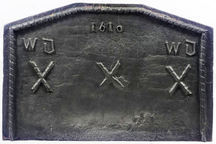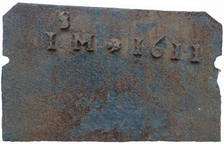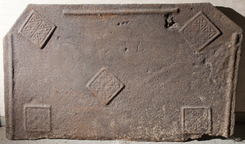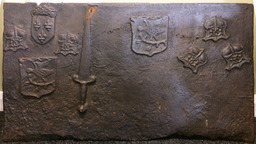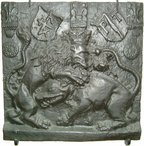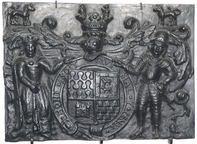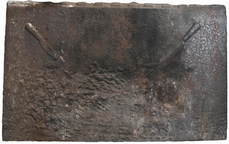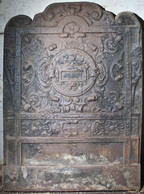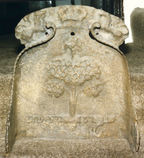-
892
Description: Canted rectangular shape; plain edging with inset ?leather strap twisted round dowel (top and sides); top centre, date probably in stamped numerals; twisted leather strap saltire repeated three times across middle of plate; pair of stamped initials, formed of a Roman 'W' and a Gothic 'd', above each outer saltire.
Notes: Sotheby's sale London 27 November 2006, lot 324; formerly at Brunger, Kent (near Tenterden).
Inscription: 1610 / WD WD
- Decoration tags:
- rectangular with canted top corners (shape)
- none (edging)
- simple stamps
- individual letters
- individual numbers
- apotropaic
- text
- objects
Manufactured: in 1610 in England.
Current location: not known.
- Attached to series:
- Date & initials firebacks
- Miscellaneous stamp firebacks
-
1167
Description: Canted quasi-rectangular shape; no edging; parallel with top edge, initials in triad to left, separated from date by a small, ill-defined flower stamp.
Notes: The serifed character set is boldly impressed, although the S is indistinct, suggesting that some of the moulding sand may have filled the impression before casting. The indentations on each side were cut to accommodate mouldings. Tennants Auctioneers sale, Leyburn, North Yorkshire, 20 March 2015, lot 781.
Inscription: ISM [triad] 1611
- Decoration tags:
- rectangular with canted top corners (shape)
- none (edging)
- individual letters
- individual numbers
- text
- plants
Manufactured: in 1611 in England.
Current location: not known.
- Attached to series:
- Date & initials firebacks
-
1089
Description: Canted quasi-rectangular shape with no edging; straight length of ?dowel placed parallel to top and to each side; square stamp with fillet edge and four diagonally quartered squares repeated five times, three rotated with sides 45 degrees to the vertical in top corners and slightly left of lower centre, and two, unrotated, repeated twice in bottom corners.
Notes: The square stamps may be pastry moulds.
- Decoration tags:
- rectangular with canted top corners (shape)
- none (edging)
- simple stamps
- carved stamps
- objects
Manufactured: in the mid- to late-16th century in the Weald area of England.
Current location: Authentic Reclamation, Lymden Lane, Ticehurst, East Sussex, England.
- Attached to series:
- Crossed square Wealden series
- Food mould stamp firebacks
-
1109
Description: Rectangular; plain edging; asymmetrical arrangement of stamps: top right, three 'renaissance' style shield stamps with a 'PL' monogram above two [?]bougets, in a triangular arrangement bases uppermost; top centre, a shield, indented at the top, charged with a bird upon a branch; top left, crowned shield of France Modern between two inverted 'PL' monogram shields above a bird shield; to the right, a broad bladed dagger, point uppermost.
Notes: The dagger is of the cinquedea style, introduced from Italy in the early-16th century, length approx. 38cm; the bird shield stamp has been seen on other firebacks. Wilkinson's Auctioneers, Doncaster, 24 Feb 2019, lot 534 (£650).
Inscription: PL [in five shields]
Arms: 'France Modern'
- Decoration tags:
- rectangular (shape)
- none (edging)
- simple stamps
- carved stamps
- heraldic
- monogram
- armorial
- royal
- objects
Manufactured: in the early- to mid-16th century in the Weald area of England.
Current location: not known.
- Attached to series:
- Bird shield series
- Knife & Dagger stamp firebacks
-
739
Description: Rectangular; a crowned lion fighting a boar in high relief on a raised bottom panel; above, a stamp formed from a fleur-de-lys on a bracket repeated three times, centre left and right corners; two angled shields and two sunburst discs.
Notes: The shields probably signify civic or personal allegiance; the symbolism of the fighting beasts is not known. Part of the bequest to the Victoria and Albert Museum by Lieut. Colonel G. B. Croft-Lyons in 1926.
Inscription: P T
- Decoration tags:
- rectangular (shape)
- none (edging)
- whole carved pattern
- heraldic
- armorial
- text
- animals
Manufactured: in the late-16th to early-17th century in Germany.
Current location: Victoria & Albert Museum, Cromwell Road, Kensington & Chelsea, Greater London, England.
Museum number: M.576-1926 (part of the Victoria & Albert Museum museum group)
- Attached to series:
- Foreign armorial firebacks
-
740
Description: Plain rectangular plate; shield, garter, helm, mantling and supporters of the Blount family, Lords Mountjoy.
Notes: The arms are those of Charles Blount, 8th Baron Mountjoy, who was invested Knight of the Garter in 1597. He was created 1st Earl of Devonshire in 1603. Blazon: 1. (Blount) Barry nebuly of six Or and Sable; 2. (Ayala) Argent, two wolves passant Sable on a bordure of the first eight saltires Gules; 3. (Mountjoy) Or a tower Azure; 4. (Gresley) Vair. An unusually bold and detailed casting; the buckle missing from the garter suggests that this plate has been cropped from a larger fireback.
Inscription: HONI·SOIT·QVI·MAL·Y·PENSE
Arms: Charles Blount, KG, 8th Baron Mountjoy
- Decoration tags:
- rectangular (shape)
- none (edging)
- whole carved pattern
- armorial
- text
Manufactured: in the late-16th to early-17th century in England.
Current location: Victoria & Albert Museum, Cromwell Road, Kensington & Chelsea, Greater London, England.
Museum number: 323.1907 (part of the Victoria & Albert Museum museum group)
- Attached to series:
- Personal armorial firebacks
- Mountjoy series
-
1279
Description: Plain rectangular shape with chamfered and embattled top edge; impression of a utilitarian, domestic knife inclined, blade down, at an angle of about 45 degrees from inside the top corners; the knife measures about 20.5cm in length.
Notes: An unusual, if not unique, top edge. The form of the knife suggests a late-16th or early-17th century date. The uneven surface of the lower part of the fireback may have been caused by the pouring of the molten metal and the consequent disturbance of the casting sand of the mould.
- Decoration tags:
- rectangular (shape)
- none (edging)
- simple stamps
- objects
Manufactured: in the late-16th to early-17th century in the Weald area of England.
Current location: in private hands, Wadhurst, East Sussex, England.
-
1252
Description: Quasi-arched rectangular shape; no edging; arched rectangular central panel edged with a garland within a cartouche between guilloche-moulded bands that extend vertically below to form two further panels separated by a similar but plain band; the two bottom panels each extend sideways to form simulated pedestals; below is a plain, borderless panel. Within the main panel, at each corner a cherub head facing towards the centre; within the border of the panel, a symmetrical strapwork band forms the edge of a cartouche that is scrolled at the bottom and which curves away from the edge of the panel at the sides to reveal scrolls from behind, and which forms a heart shape in front of each of the putti enclosing an indeterminate feature; in the centre of the panel, resting upon a scrolled cartouche with scallop shells to left and right, a gadrooned medallion enclosing the depiction of an empty mural monument, draped from above and with a lion's mask below. Resting upon the pedestal to the right, a consol enclosing an indeterminate circular feature with two descending bands; on the pedestal to the left a similar consol and indeterminate circular feature but with a single descending band; above each consol the head of a classical deity facing to right and left respectively, above which are rows of vertical figures, four on the left and two on the right, which may be caryatid figures possibly intended to depict the Daughters of Athens on the Parthenon; above the main panel symmetrical scrolls. In the lower panel, a central rectangular cartouche, scrolled at the top and bottom, between symmetrical vignettes.
Notes: Some of the detail is too indistinct to permit accurate description, but a fireback of untypical design features that are all characteristic of the early-17th century, and derivative of the designs of the likes of Jan Vredemen de Vries and Frans Huys.
Copies of this fireback are known.
- Decoration tags:
- rectangular with ornate arch (shape)
- none (edging)
- whole carved pattern
- architectural
- humans
- objects
Manufactured: in the early- to mid-17th century in England.
Current location: in private hands, Wartling, East Sussex, England.
- Attached to series:
- Miscellaneous pattern firebacks
-
1223
Description: Rectangular; no edging; top centre, inscription, FF, and date, 1732, separated by a small saltire.
Notes: The possibility exists that the initials are those of Francis Fairburn, whose descendants are known to have occupied the house where it lies.
Inscription: FFx1732
- Decoration tags:
- rectangular (shape)
- none (edging)
- individual letters
- individual numbers
- text
Manufactured: in 1732 possibly in the Weald area of England.
Current location: in private hands, West Peckham, Kent, England.
- Attached to series:
- Date & initials firebacks
-
1069
Description: Quasi-arched shape with forward-facing 'wings', which splay outwards towards the base where each has been pierced with a small hole as if to insert a rod from one side to the other; the 'wings' curve to follow the shape of the main panel but curl outwards at the top; central panel with stylised tree decoration surmounted with a crown between two inward-facing animals, possibly a lion and unicorn; beneath the tree, a partially illegible inscription in relief.
Notes: Nothing is known about the sources of free-standing firebacks or what prompted their production. Their form is similar and the predominant use of horticultural or arboreal decorative themes suggests production within a limited time frame. Only a very small number of such castings are known. Depth 200mm. A similar fireback, noted at Poynings in Sussex, was illustrated in The Connoisseur, vol 41 (April 1915), p. 221; it too had a crown supported by a lion and unicorn on the top, and a tree with an illegible inscription below.
Inscription: SYLVESTR..[illegible]
- Decoration tags:
- free-standing (shape)
- none (edging)
- whole carved pattern
- text
- plants
Manufactured: in the late-17th to early-18th century in England.
Current location: in private hands, Wigmore, Herefordshire, England.
- Attached to series:
- Free-standing firebacks
